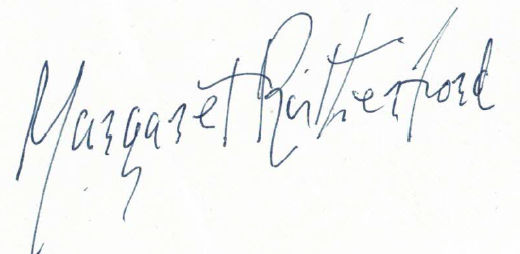Short biography
Margaret Rutherford
was the daughter of William Benn and Florence Rutherford († 1895). Her father was considered insane: he slew on March 4th, 1883 his own father the Reverend Julius Benn with a chamber pot. In 1904 he was sent to the Broadmoor Hospital for criminally insane and was not released until seven years later into the custody of his brother John Benn. To spare her the taint of her father’s name, she received the surname of their mother Florence Rutherford. Her mother died when Margaret was three years old. She grew up with her aunt Bessie, her deceased mother’s sister. Margaret visited Wimbledon High School and then took piano lessons and after Aunt Bessies Death in 1925 she took acting lessons at the famous Old Vic School. 1925 Margaret Rutherford had her stage debut. Her rough voice and her energetic appearance made a theatre star of her in the late 1930s. Finally, in 1936, she played a female member of a gang of counterfeiters in the film „Dusty Ermine“ – her first film role at the age of 44. The final breakthrough on stage came in 1939 with the part of Miss Prism in Oscar Wilde’s classic „The Importance of Being Earnest“. A significant role which she also starred in the film adaptation of this play in 1952. Because of her quirky-energetic performances and her unmistakable appearances he often was called the english „Adele Sandrock“ (a german actress).
Due the presentation of the lady detective Miss Marple in four popular movies, she got (up to date) a very large fancomunity aound the world and especially in Germany. Agatha Christie, the inventor of „Miss Marple“, was disappointed by the films, because Rutherford’s boyish-bold portrayal was far removed from the process invented by Christie’s natured-roofed detective. However, during the shooting of „Murder she said“ both women learned to know personally and became friends. Christie dedicated her 1963 novel The Mirror Crack’d From Side to Side“, which was filmed in 1980, starring Angela Lansbury as Miss Marple.
Rutherford played in many other films, and was usually set to more quirky characters. For the presentation of the bankrupt Duchess of Brighton in the movie The V.I.P.s she won an Oscar in 1964 for best supporting actress. In 1961 she was appointed Officer of the British Empire (OBE) and 1967 for her successful theatre work she became Dame of the British Empire (DBE) applicable to knighthood. Shortly before her death, she published her autobiography titled Margaret Rutherford (as told to Gwen Robyns).
She once described her career with a few words:
„My success came late, but – if I may say so – quite sensational in nature.“
Margaret Rutherford was married to the English actor Stringer Davis since 1945, with whom she starred in several films, including in the four Miss Marple films, in which he portrayed the character of the librarian Mr. Jim Stringer (in the book templates of Agatha Christie this character does not appear. His role was added on to Rutherford’s request), as well as the doormen in the The V.I.P.s.
Both adopted the writer Gordon Langley (not legal, more a „heart-adoption“) in the early 60s , in the late 60s he became a she – one of the world’s first gender reassignments. Afterwards she wrote books under the name Dawn Langley Simmons (including a biography of Margaret Rutherford in 1983). The British politician Tony Benn (1925-2014) was Rutherford’s cousin. The last yers of her life she suffered from Alzheimer’s disease. She died in 1972, eleven days after her 80th birthday of complications that had arisen from a dental procedure and pneumonia. She was buried on St. James Church Yard, Gerrards Cross in Buckinghamshire. 1973 her husband James Buckley Stringer Davis was buried next to her.
(source: wikipedia)
